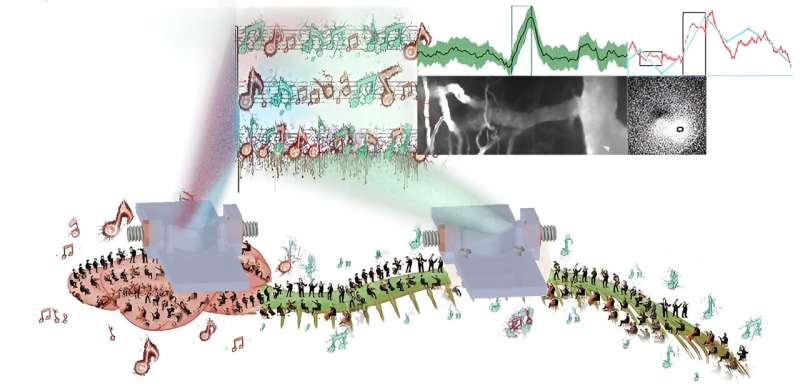This article has been reviewed according to Science X's editorial process and policies. Editors have highlighted the following attributes while ensuring the content's credibility:
fact-checked
trusted source
proofread
Bioluminescence and 3D-printed implants shed light on brain–spinal interactions

A sensory process such as pain is no ordinary phenomenon—it's a symphony of neural and vascular interactions orchestrated by the brain and spinal cord. Attempting to dissect this symphony by focusing on a single region is like trying to understand a complex melody by listening to just one instrument. It's incomplete, potentially misleading, and may result in erroneous conclusions.
Enter the Carney Institute's team of visionaries. Their mission? To develop tools that allow unprecedented observation of neural and vascular activity within the brain and spinal cord. They have recently tackled two critical fronts: imaging hardware and bioluminescent (BL) molecular tools.
Innovative imaging hardware
Multi-organ imaging during clinically relevant sensory processes is notoriously challenging. As a result, until now there were no methodological protocols and tools that would offer any guidelines on how to go about imaging multiple sites during clinically relevant sensory behaviors. As reported in Neurophotonics, the team engineered 3D-printed brain and spinal cord implants, revolutionizing surgical implantations and optical access.
Wearable miniscopes coupled with universal implants for advanced microscopy or optogenetic stimulation now provide a backstage pass to the brain and spinal cord.
Bioluminescent imaging
BL imaging overcomes limitations of more traditional fluorescent microscopy. No more photobleaching, phototoxicity, or resolution loss due to scattered excitation signals.
The team conceived the "BLmini," a modified miniscope optimized for capturing these elusive BL signals.
The Carney Institute's "universal" implants allow simultaneous acute and chronic imaging of brain–spinal interactions. Imagine watching a live concert from both the orchestra pit and the balcony—now apply that to neural circuits. The BLmini, with its reduced weight, cost and form-factor, is the star performer, revealing hidden signals like never before.
This coalition of 3D-printed implants, advanced microscopy tools, and bioluminescence techniques holds promise beyond pain research. Neuropathic pain, sensory disorders, and motor behavior are all within its reach. As the spotlight shines on the brain–spinal duet, we're one step closer to unraveling the symphony of sensory phenomena.
More information: Dmitrijs Celinskis et al, Toward a brighter constellation: multiorgan neuroimaging of neural and vascular dynamics in the spinal cord and brain, Neurophotonics (2024). DOI: 10.1117/1.NPh.11.2.024209




















